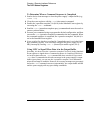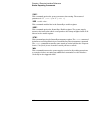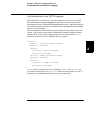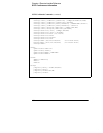
Chapter 4 Remote Interface Reference
An Introduction to the SCPI Language
116
Querying Parameter Settings
You can query the value of most parameters by adding a question mark (?) to
the command. For example, the following command sets the output current
to 5 amps:
‘‘
CURR 5
’’
You can query the value by executing:
‘‘
CURR?
’’
You can also query the minimum or maximum value allowed with the present
function as follows:
‘‘
CURR? MAX
’’
‘‘
CURR? MIN
’’
Caution If you send two query commands without reading the response from the first, and then
attempt to read the second response, you may receive some data from the first response
followed by the complete second response. To avoid this, do not send a query
command without reading the response. When you cannot avoid this situation, send
a device clear before sending the second query command.
SCPI Command Terminators
A command string sent to the power supply must terminate with a <new line>
character. The IEEE-488 EOI (end-or-identify) message is interpreted as a
<new line> character and can be used to terminate a command string in place
of a <new line> character. A <carriage return> followed by a <new line> is
also accepted. Command string termination will always reset the current SCPI
command path to the root level. The <new line> character has the ASCII
decimal code of 10.
IEEE-488.2 Common Commands
The IEEE-488.2 standard defines a set of common commands that perform
functions like reset, self-test, and status operations. Common commands
always begin with an asterisk ( * ), are four to five characters in length, and
may include one or more parameters. The command keyword is separated
from the first parameter by a blank space. Use a semicolon ( ; ) to separate
multiple commands as shown below:
‘‘
*RST; *CLS; *ESE 32; *OPC?
”


















